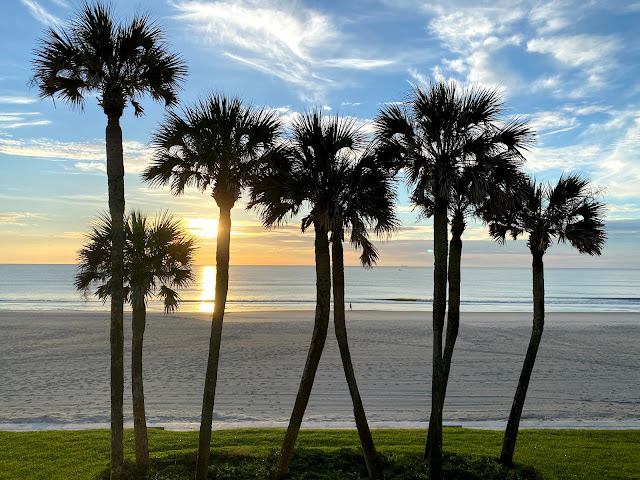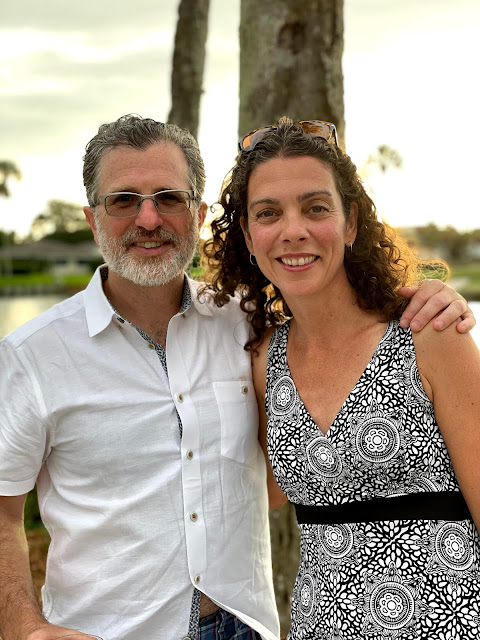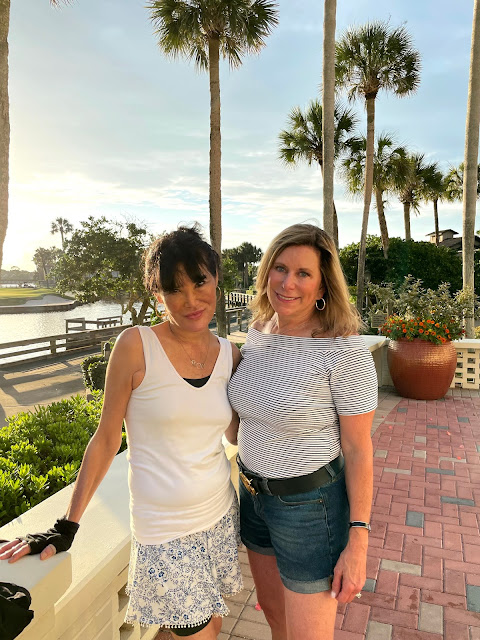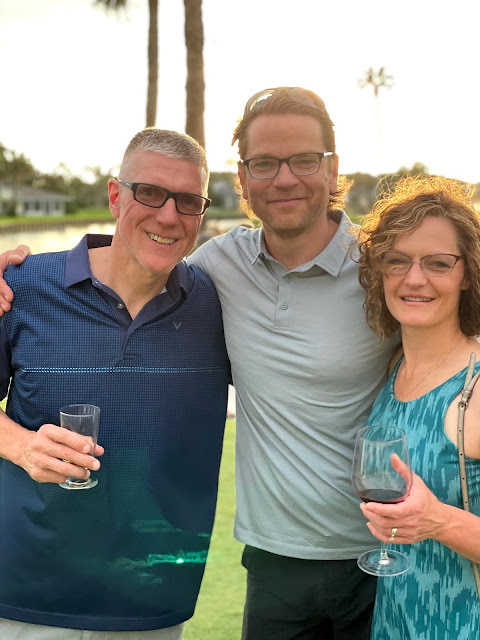Ponte Vedra, FL July 2021
From July 8 - July 10, 2021, after being forced to cancel the 2020 meeting, Manus gathered on the northeast shore of Florida. Present, physically, at this year's meeting were Randy, Kristin, Jon, Lou, Marc, Becky, Lana, Warren, Dan, Rob, Peter, and Milan. Tom joined a day later. Present, remotely, at various times were Phani, Jeff, Jeff, Adam, Sunjay, and Bassem. It was great being able to include those who could not physically make it to Florida.
Well, some of us almost didn't make it to Florida, thanks to Hurricane Elsa. She passed right over Jacksonville as some of us were navigating the highways or approaching the runway. Fortunately, all made it safe and sound.
And this was my commute to the conference. Not too shabby!
July 8 - Day 1
Lou started us off with a truly remarkable feat of teamwork and dedication. He presented a case of a combined face and double hand transplant. The patient is an 18 year old man who fell asleep at the wheel after working a double shift. He was pulled from his burning car with third degree burns over a large part of his body including his face and both hands.
A team of dozens of surgeons, anesthesiologists, residents, and nurses was assembled. One Saturday a month for eleven months the team gathered for full-length rehearsals. Detailed operative checklists were developed for each team. Longitudinal teamwork evaluations were performed and the entire team was debriefed after each rehearsal. The procedure was tweaked and the whole thing was repeated the following month. After nearly a year, a suitable donor was identified and the team was called in. The surgery was an incredible success. Lou showed videos of the patient’s range of motion, and even showed him lifting weights. Truly remarkable. Congratulations, Lou!
One of many news reports on the surgery:
https://www.youtube.com/watch?v=KaMXUXasnfs
Dan then presented his strategy for the management of spasticity. Currently, treatment consists of surgery, botox, and rehab. And this is pretty much what is done almost everywhere. BUT, way back in 1913 German surgeon Adolf Stoffel said “No more tendon transfers!” Did we listen? Clearly we did not. Stoffel talked about nerve surgery instead of tendon surgery.
Selective denervation: you only need 20% of axons to have a normally functioning muscle. You can do 60-80% selective denervation without sacrificing muscle function. Dan, like Adolf, is encouraging us to think about nerve injury a different way.
Dan’s spasticity presentation on YouTube:
https://www.youtube.com/watch?v=sY4qSwrXKRM
Also, see littlearms.org for specific surgical techniques like the flexor-pronator slide. Hopefully we will be seeing fewer wrist fusions and tendon transfers for the treatment of spasticity, in both children and adults. Thanks, Dan!
On a side note, a discussion of personal headlights took place. Some recommendations included Designs for Vision, Lumadent, and Surgitel (lighter than the DFV version). These came highly recommended by several members. I know I’m getting one for my aging eyes!
Rob presented his preferred technique for SEFCF - parallel k-wires between the capitate and lunate to cause mid carpal settling and fusion. “Stiff and stable - that’s the Kaufmann way!” In a review of his cases, he had 100% fusion (64/64). May be a good alternative for those with poor bone stock, smokers, and others with higher risk of nonunion using rigid techniques.
Others then talked about the use of staples for four corner fusions. Marc talked about using Synthes’s cannulated staples. Good for type I lunates; with type II, include the hamate in the fusion. But folks had issues with dorsal impingement with staples. Warren recommended burring a 2mm trough for the staples - you don’t lose any stability taking this amount of bone, and seating the staples like this avoids the problem of impingement.
Endo Pharmaceuticals - our sponsors for this year’s meeting.
They led a discussion about how things have changed in our practices over the last year plus. Volume still appears to be down for beds, and in New York City. Others seem to be back up close to normal in terms of volume. Many are still using Telehealth. But what is going to happen with this modality in the future?
They talked about the Elway campaign and how they encourage, patients with Dupuytrens to go to their website to find doctors who perform collagenase injections. Factsonhand.com.
Social time!
We adjourned for the day and everyone enjoyed the day by the pool, at the beach, shopping, golfing, and, I believe, fishing.
I discovered this little nugget in St. Augustine: Florida state song: "Old folks at home".
We reconvened at the West Lawn and everyone took part in Shoot for the Pin. We lost many a golf ball but only one club. And Jon came out the winner, coming within 2 meters of the pin.
Dinner was a delicious buffet, and this was when we really got a good look at how the Manus families have gown up. The boys are men; the girls are women; and we are as young and vibrant as ever!
July 9 - Day 2
Marc led off Day 2 with a new technique for thumb MCP arthrodesis. Tension band wiring is a popular technique for fusing the thumb MCP joint. But to get proper fixation, you need bicortical purchase with the k-wires. If you use k-wires with eyelets, like the ones that are in the Acumed elbow set, there is no need for bicortical fixation. Post-op: 2 weeks in a splint, then a removable splint and start therapy for flexion exercises. Increase activity at 6 weeks.
As usual, we went off on a tangent, and discussed various CMC arthroplasty techniques. 2 people present use the tightrope routinely for primary cases. Everyone else use some form of LRTI/APL suspensionplasty.
Warren introduced a discussion of STT arthritis. Is it really isolated STT arthritis or is it an indicator of midcarpal instability? Check the lateral view fo DISI deformity. What is the right answer? Many options: Excision of the distal scaphoid? (but not more than 3mm says Lou!); CMC arthroplasty with partial trapezoidectomy?; Resect small portions of the trapezium and trapezoid? 4 corner fusion? PRC? Or inject the joint until it auto fuses as with a carpal boss, suggests Tom. No right answer.
Rob then introduced us to arrch orthopaedics.
Over the last several years Rob has presented to us his observations of the shortcomings of total elbow replacements. We have heard about the evolution of design, modes of failure, success rates, etc. This year, Rob has presented us with a solution. For the last 10 years he has been working on a revolutionary design for a total elbow. Through thousands of hours of pencil drawing, designing, CAD drawings, refining, learning 3D software, machining, iterating and reiterating, Rob came up with something that could solve many of the issues currently plaguing existing total elbows. But, because it would not be commercially lucrative, he has had to go it alone, with support only from his wife Heather. They approached the FDA, and after many proposals, the design is almost at the point of approval for early feasibility studies. Fingers crossed! Rob passed around an example of the implant, and I have to say, I am in awe. We salute you, Rob, for your dedication and tenacity to do something right, and to make something better.
Phani spoke about Elbow MCL reconstruction. A procedure that is done in a select population of elite throwing athletes, who place an extreme values force on the MCP during late cocking and acceleration. Get an MR arthrogram - shows the injury much better. Do not make surgical decisions based on MRI alone. Measure the lengths of the tendon graft limbs carefully. Transpose the ulnar nerve only if they are having ulnar nerve symptoms. Protect the MABCN, protect the ulnar nerve when drilling the distal tunnels. Open the native ligament to see the joint. Make sure the bone bridge is at least 1cm from the joint line. Tension the graft with the elbow in 30 degrees of flexion, and full supination to reduce the ulnohumeral joint. Fine tune with side to side sutures as tight as possible.
Post-op algorithm: splint in 70 degrees of flexion. At 10 days begin AROM. At 4-6 weeks start strengthening. At 3-4 months begin throwing. 12-18 months are the final stages of recovery, when they can get back to elite throwing.
Next year
Nominations for next year’s meeting were as follows (looking for a “west coast” location”:
Dude ranch
Hawaii
Monterey
San Diego/So Cal
Laguna beach/Orange County
Santa Barbara
Ojai Valley
Napa/Healdsburg
Flathead Lake Lodge, Montana
Vancouver
Bryce/Zion
Park City, Utah
Disneyland/Universal
Rush Creek Lodge Yosemite
The afternoon was spent at the pool (again), at the beach (again), or fishing for comb jellies from kayaks along the famous Florida waterways.
We tried to gather the families for a group photo before dinner but were thwarted by this:
But only minutes earlier there was this:
Fortunately, no one had actually made it to the beach before the rains came. We did manage to get these though!
Damn we are a good looking bunch! Dinner was limited to adults only that evening. We dined on delicious local cuisine specially chosen for us by Ali. President Marc said a few words extolling the awesomeness of this group.
Then there was a spontaneous outpouring of Manus love as members and their SOs took turns expressing their gratitude for this family that we have assembled. We reminisced about how we got started with Manus, and about how it has come to be such an important part of our lives. This was possibly my favorite part of the whole meeting. Excuse me - I need to get myself a tissue.
July 10 - Day 3
Warren led us off with a discussion of PROMIS in hand surgery. UR has been collecting data since 2015. The goal is to measure value in healthcare. This is a biopsychosocial model. The mental aspects of health play an important part in how the patient does - resilience, depression, anxiety, pain interference, coping skills. Not just how things look on X-ray or final path results. Patients with depression and higher pain interference levels recover more slowly and not to the same extent. PROMIS is based on this biopsychosocial approach, and is comparable across specialties. The trends discovered in this way are more useful for individual patients and assisting their recovery.
Adam led a discussion about “teaching” in the OR. It is a different challenge now than it was in years past. What do you allow residents to do in the OR? Is it different now, with the reduced work hours? Do you use simulators or virtual reality technology? What do you do to manage your anxiety when students or residents are operating? Do you have lower expectations for medical students and residents with the 80-hour work week, remote conferences, and a general feeling of entitlement? And what can be done about it??? Hats off to those of you who do this on a regular basis. It takes a special talent, and a degree of patience that I am unfamiliar with.
Marc then introduced us to Restor3d - 3D printing for cutting guides, as well as titanium and cobalt chrome plates and other implants. Use CT scanning and 3D modeling of the uninjured other side to create the guides or implants. He showed a case of a 28 year old Air Force mechanic with a distal radius malunion. Great flexibility in sizes and shapes. Just another awesome addition to our fracture fixation armamentarium.
The 2022 Meeting





































